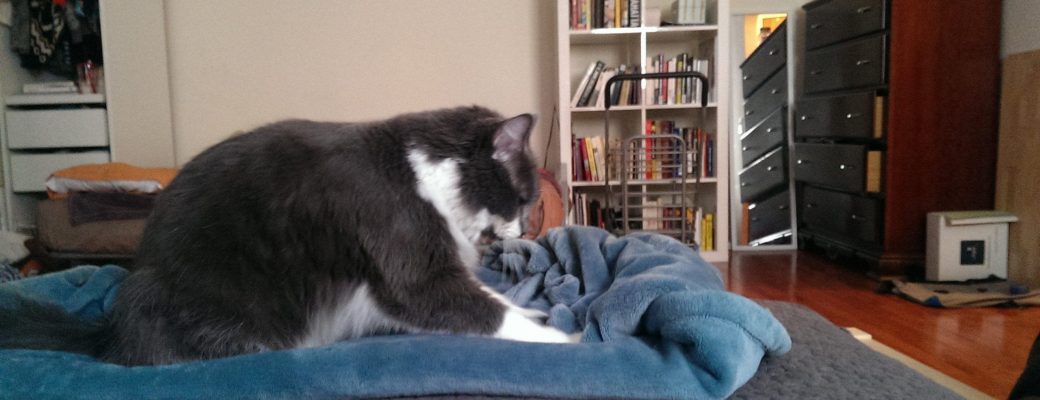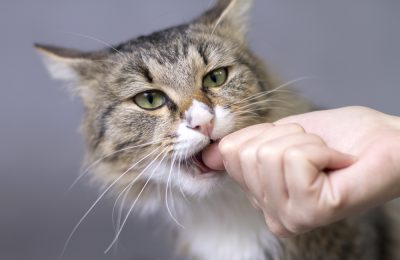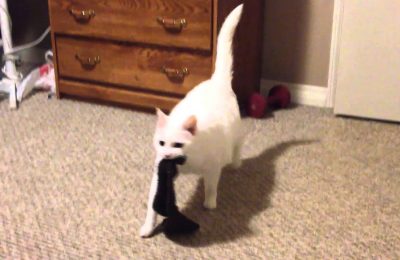Is Salmon Good for Cats & Kittens to Have? Cooked or Raw Salmon is always considered…
Cat Kneading and Biting Blanket
Why Do Cats Bike Blankets While Kneading?
If you are one of the lucky people in the world that just so happens to be owned by a cat, you are more than likely familiar with just how entertaining these amazing furry creatures can actually be. Behind all of that tough feline faced, there is an endless amount of laughter, comedy, and even quirkiness. This can come in many different forms, but when you notice that your cat is continually kneading and biting a blanket, it is going to be one of the most unexpected quirks that you would ever expect. With that being said, you may have wondered why it is that your cat is actually kneading and biting a blanket?
Why Your Cat Kneads and Bites a Blanket
If you have ever had a litter of kittens, then you already know that they will knead and bite at their mother’s nipples in order to get the milk to release. While most of the cats that you come across will eventually outgrow this particular behavior, there are some cats who will simply find it to be very comforting throughout their entire life. So, when you see your cat kneading and biting a blanket, it essentially means that your cat has claimed that blanket as their own. This is because of the scent glands that can be found in your cat’s paws.
Here is everything that you need to know about why your cat kneads and bites a blanket.
What Exactly is Cat Biting and Kneading?
Before you are really able to understand why your cat does this habit, you must first understand what biting and kneading a blanket actually is. Kneading is going to be a term that is oftentimes referred to as ‘making bread or biscuits’ but is when your cat presses their claws in a repeated motion into a soft surface (for example, a pillow, blanket, clothes, or cushion). You may have noticed that your cat has done this to you as well, meaning that they are claiming you as their very own.
When your cat kneads, they are going to be pushing their feet in and out of whatever surface they may be sleeping on. More often than not, you can expect them to use their claws, normally retracting every time that they pull back. They will repeat this movement one paw at a time, alternating with each push. While your cat is doing this, you may notice that they are also sucking or biting the blanket (or whatever they are kneading) as well. This is also going to be a very common thing that cats do. However, if you start to notice that your cat has begun to actually eat the blanket as opposed to just suck on it, this is something that you should alert your local veterinarian to, as they may have a condition known as feline pica. Feline pica is a cat condition where your cat will eat stuff that is not actually food.
Why Your Cat Kneads and Bites Blankets
While most of the cats that you come across will outgrow their need to knead and bite, there are some who will continue to do it into their adulthood. Many cat parents will mistake this activity of kneading and biting as a special claw sharpening behavior, but the reasons they do it are very different and much more complex than you may think.
They Consider it a Nursing Technique
When it comes to nursing, it is a natural thing for cats to do. In fact, it is actually going to begin from the moment that your cat is born. When they are nursing, they will require their mother’s nipple if they are to nurse successfully. It is going to be this very simple movement that will stimulate the milk production in the mother cat. On top of that, kittens are also going to run to their mother’s whenever they seek comfort and will even nurse until the mother cat has ran dry of more milk.
When it comes to your cat adopting and continuing this behavior later in their life, is for the main reason that they were separated from their mother much too soon. There are some that have suggested that kittens who are bottle fed will knead as they mature, but this has not been proven as a side effect of being bottle fed as a kitten.
Aside from just kneading, you may have a cat that is also going to bite or suck at your blanket as well. This is not a very uncommon behavior and could also be some type of leftover from when your cat was just a kitten. Sucking and biting at any type of warm and soft item may simply be something that comforts your cat and reminds them of their mother.
Wild Tendencies
There are some theories out there that suggest your cat’s behavior of biting and kneading go back to a time before cats were ever domesticated. According to them, wild cats living on their own would knead and even pat down the different types of foliage in their habitat in order to make the ground softer for them to give birth or sleep on. With that being said, there is a chance that your cat is only following their instincts just like their ancient ancestors did before they go to sleep.
They are Claiming the Blanket as Their Own
One of the other reasons why your cat may be kneading and biting at a blanket is to let you and any other pets there might be in the house know that it is their territory. Cats actually sweat from the soft part of the pads on their paws, as well as have a special set of scent glands there too. This means that while they are kneading that blanket, they are also releasing a special scent onto its surface as well, essentially marking it as their territory.
You may notice this happens on a much more regular basis if you have multiple cats as pets in your household. In these multi-cat household situations, the need for your cats to establish some type of rule over something in the home will be much more prevalent. For example, you have probably noticed how each of your cats will have a sleeping spot that they prefer over any other, no matter if it is on your bed or on a blanket of their own. When they knead the blanket, it is going to be the most common way to keep any of the other cats in the house away and ensure them that it will always be readily available to them at the same time.
Comfort and Relaxation
Keeping in mind that kittens will knead on their moms when they are nursing and many of these kittens will continue practicing this habit as they grow into adulthood. In fact, you may even find that your cat will knead you from time to time. They do this as it allows them to soothe themselves, even potentially helping them achieve a ‘trance-like’ state of mind. What this means is you may need to watch out for drooling.
When cats are sleeping, they are going to feel much more vulnerable than when they are awake. So, the fact that they knead on a blanket in order to feel more comfortable and create a sense of extra safety, just makes sense. When your cat kneads and bites on a blanket or something else that is warm and fuzzy, it releases a nursing instinct that they have. So, you may even find that your cat is purring while it kneads that blanket. If you do display this behavior, it is nothing that should alarm you. In fact, the very opposite is actually true. You should take this behavior as a sign that your cat is very happy and content. You may even feel as though you might want to try kneading and biting on a blanket to help yourself de-stress as well!
It is a Sign of Trust
No matter if your cat is kneading you while they sit on your lap, or if they are kneading your blanket and clothes, the big takeaway is that it is a sign of affection and trust towards you. When they knead you, it is a huge sign of comfort and trust.
When it comes to your pet cat, you will notice that they have many peculiar habits that they will do from time to time. Some of them may make you laugh, some may make you unhappy, and some will make you say ‘huh’? As far as biting and kneading on a blanket or something else in the household that is soft and furry, it basically means that your cat is happy and feeling very comfortable in your home and with you. So the next time you see your cat kneading and biting a blanket, be sure that you give them some extra affection to make them the happiest cat ever.





This Post Has 0 Comments